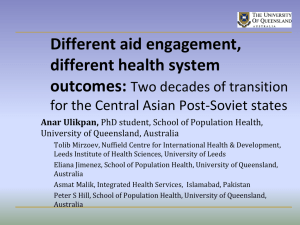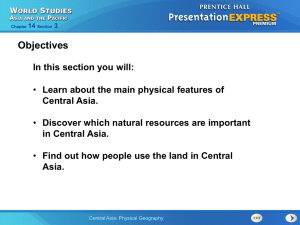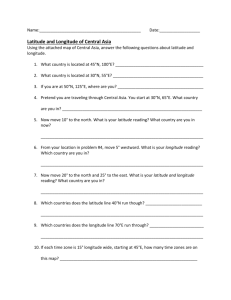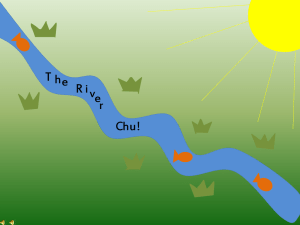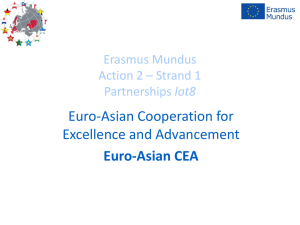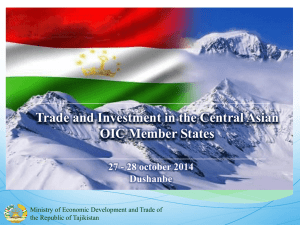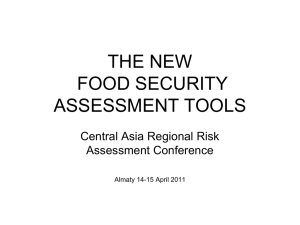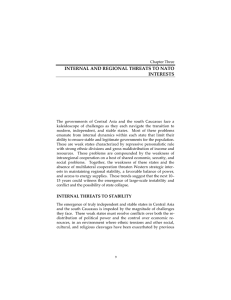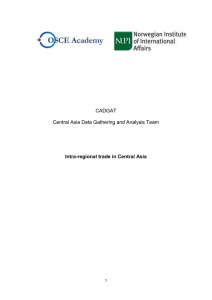CENTRAL ASIAN INFORMATION TECHNOLOGY DEVELOPMENT
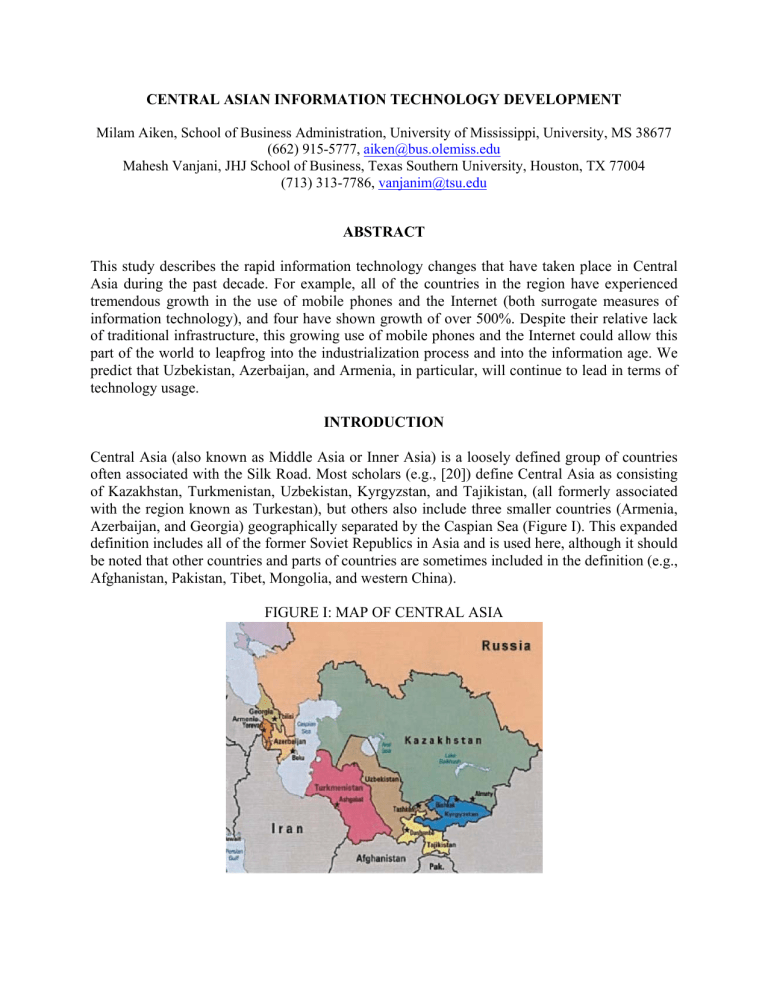
CENTRAL ASIAN INFORMATION TECHNOLOGY DEVELOPMENT
Milam Aiken, School of Business Administration, University of Mississippi, University, MS 38677
(662) 915-5777, aiken@bus.olemiss.edu
Mahesh Vanjani, JHJ School of Business, Texas Southern University, Houston, TX 77004
(713) 313-7786, vanjanim@tsu.edu
ABSTRACT
This study describes the rapid information technology changes that have taken place in Central
Asia during the past decade. For example, all of the countries in the region have experienced tremendous growth in the use of mobile phones and the Internet (both surrogate measures of information technology), and four have shown growth of over 500%. Despite their relative lack of traditional infrastructure, this growing use of mobile phones and the Internet could allow this part of the world to leapfrog into the industrialization process and into the information age. We predict that Uzbekistan, Azerbaijan, and Armenia, in particular, will continue to lead in terms of technology usage.
INTRODUCTION
Central Asia (also known as Middle Asia or Inner Asia) is a loosely defined group of countries often associated with the Silk Road. Most scholars (e.g., [20]) define Central Asia as consisting of Kazakhstan, Turkmenistan, Uzbekistan, Kyrgyzstan, and Tajikistan, (all formerly associated with the region known as Turkestan), but others also include three smaller countries (Armenia,
Azerbaijan, and Georgia) geographically separated by the Caspian Sea (Figure I). This expanded definition includes all of the former Soviet Republics in Asia and is used here, although it should be noted that other countries and parts of countries are sometimes included in the definition (e.g.,
Afghanistan, Pakistan, Tibet, Mongolia, and western China).
FIGURE I: MAP OF CENTRAL ASIA
Many in the Western world knew little about this part of the world until relatively recently, but there has been growing interest with the advent of war in Afghanistan [3] [10], the appearance of the movie ‘Borat’ [6] [17], the possibility of conflict with Iran [9], and the rise in importance of oil in the region [2] [23]. Apart from the remoteness of area, the relative poverty of these countries has heretofore caused a lack of awareness. However, most have made great strides in economic growth (especially those that are rich in oil) and many have experienced rapid surges in technological modernization in the past decade, in part because the use of technology is vital to economic development [11] [19] [21]. For example, the rapid productivity growth observed in the United States in the mid- to late 1990s has been attributed by some to the rapid growth in the use of the Internet [6].
As part of this new interest, the University of Washington and Harvard University have established research centers devoted to the study of information technology in this area of the world, but only a few papers have been published on this development (e.g., [4] [24] [25] [27] ).
Here, we extend this research by reporting on the status of information technology growth as measured by telephone, mobile phone, and Internet use in Central Asia and discussing the outlook for continued progress.
STATUS OF DEVELOPMENT
Countries in Central Asia vary tremendously in size, population (Figure II), and economic development (Figure III). Information technology development (as measured by Internet use) also varies widely (Figure IV), but like many poorer nations in the world (Figure V), is relatively low.
FIGURE II: CENTRAL ASIA RELATIVE POPULATION PERCENTAGES
(Source: CIA, 2007)
Population %
Uzbekistan,
36.53%
Armenia,
3.88% Azerbaijan,
10.67%
Georgia,
6.10%
Kazakhstan,
19.97%
Turkmenistan,
6.57% Tajikistan,
9.33%
Kyrgyzstan,
6.96%
FIGURE III: CENTRAL ASIA GROSS DOMESTIC PRODUCT PER CAPITA (2006)
(Source: CIA, 2007)
10000
9000
8000
7000
6000
5000
4000
3000
2000
1000
0
Ta jik is ta n
Uz bek ist an
Ky rg yz st an
G eo rg ia
Ar m eni a
Az er bai ja n
Tu rk m eni st an
Ka za kh st an
FIGURE IV: CENTRAL ASIAN INTERNET USERS
(Source: Internet World Stats, 2007)
Percentage of Central Asia Internet Users
Armenia, 4.62%
Tajikistan, 0.14%
Georgia, 5.04%
Kazakhstan, 11.49%
Uzbekistan, 50.12%
Kyrgyzstan, 8.04%
Turkmenistan, 1.03%
Azerbaijan, 19.50%
FIGURE V: PERCENTAGE OF POPULATION AS INTERNET USERS
(Source: AlphaWorks Services, 2007)
TABLE I : INTERNET USAGE AROUND THE WORLD
(Source: Internet World Stats, 2007)
Armenia
Azerbaijan
Georgia
Kazakhstan
Kyrgyzstan
Tajikistan
Turkmenistan
Uzbekistan
TOTAL ASIA 3,712,527,624 114,303,000 409,421,115 11.00% 258.20%
All the Americas 891,144,645 126,151,435 333,292,091 37.40% 164.20%
Europe 809,624,686 105,102,841 319,092,225 39.40% 203.60%
WORLD TOTAL 6,574,666,417 360,958,055 1,133,408,294 17.20% 214.00%
Despite its relatively low penetration in comparison with the rest of the world, Internet use has grown rapidly during the past decade in all Central Asian countries, especially in Uzbekistan and
Azerbaijan (Table I). Figure VI shows the relationship among GDP per capita, Internet use per capita, and Web pages per capita. A rough estimation of Web pages for each country was obtained using Google. For example, “site:.az” gives results for Azerbaijan.
Overall wealth of a country is one predictor of information technology use [13], but in the case of Central Asia, there is no significant correlation between GDP and Internet use (R = -0.06, p =
0.89) or between GDP and Web pages (R = 0.08, p = 0.85). In addition, there was no significant correlation between the number of Web pages and Internet use per capita (R = 0.36, p = 0.38).
One reason for the large variation in Internet penetration may be due to the differences in access costs. For example, it cost US $3 to access the Internet in Tajikistan for one hour in 2003, the second highest price charged in the region [24]. In the same period, Kyrgyzstan had the lowest charge for Internet access.
FIGURE VI: PER CAPITA GDP, INTERNET USE, AND WEB PAGES
0.1
0.09
0.08
0.07
0.06
0.05
0.04
0.03
0.02
0.01
0
Ta jik ist an
Uzb ek ist an
Ky rg yz sta n
GDP
Geo rgi a
Ar m en ia
Web pages
Az er ba ija n
Tu rk m en ist an
Internet use
Ka za kh st an
The cost of Internet access is a large problem for most of the developing world [15] [16]. One study [18] showed that the average annual access cost for 20 hours was 5% of GDP per capita or less in only 37 of the countries surveyed. At the extreme, the average cost of 20 hours access was
32%, 41%, 51%, 59%, and 115% of average per capita income in Ukraine, Vietnam, Nigeria,
Zimbabwe, Nigeria, and Bangladesh, respectively.
Another factor that could influence Internet penetration is government policy [12]. Foreignowned enterprises engendered by freer policies are more likely to have Internet access than other firms, and enterprises that compete with these foreign-owned companies are more likely to have
Internet access as well [7]. Finally, some government programs have actively sought to
encourage information technology in the region. For example, the United States has funded the
Internet Access and Training Program (IATP) that provides free Internet and computer training through 49 centers to the people of Kazakhstan, Kyrgyzstan, Tajikistan, Turkmenistan, and
Uzbekistan, allowing them to become familiar with and learn the benefits of the technology [8].
In addition to Internet usage, other measures such as fixed line phone and mobile phone subscriptions are also considered as indicators of technological development in a country [26].
Like Internet penetration, there is a large variation among the countries in terms of these two telephone technologies (Figure VII and Figure VIII).
FIGURE VII: PHONE LINES PER CAPITA IN CENTRAL ASIA
(Source: CIA, 2007)
Turkmenistan,
23.74%
Tajikistan,
6.91%
Kyrgyzstan,
3.42%
Kazakhstan,
6.12%
Phone lines %
Armenia,
15.36%
Georgia,
34.91%
Azerbaijan,
9.53%
FIGURE VIII: MOBILE PHONES PER CAPITA IN CENTRAL ASIA
(Source: CIA, 2007)
Turkmenistan,
10.39%
Tajikistan, 0.49%
Kyrgyzstan,
2.50%
Kazakhstan,
4.86%
Mobile phone users %
Georgia, 46.80%
Armenia, 21.16%
Azerbaijan,
13.79%
FIGURE IX: PER CAPITA GDP, PHONE LINES, AND MOBILE PHONES
0.5
0.45
0.4
0.35
0.3
0.25
0.2
0.15
0.1
0.05
0
Ta jik ist an
Uz be kis tan
Kyr gy zs ta n
Geo rg ia
Ar m eni a
Aze rbai jan
Tu rk m eni sta n
Ka za kh st an
Phone lines Mobile phones GDP
As seen in Figure IX, phone line subscriptions are highly correlated with mobiles phones (R =
0.87, p = 0.005), but neither is significantly correlated with per capita GDP (phone lines: R =
0.44, p = 0.28; mobile phones: R = 0.55, p = 0.16). Again, access fees and other factors may play a large part.
CONCLUSION
Like other countries in the third world with little infrastructure, Central Asia may be able to close the digital divide and leapfrog into the information age through the use of the Internet and mobile phones [22]. Mobile phones can be installed in areas that have never had land-line service, and even Internet access can be provided via satellite.
However, several barriers still remain. High access fees in some countries prevent many from utilizing these information technologies, and repressive governments have attempted to restrict their use in order to control their populations better. For example, Tajikistan has very high
Internet access fees relative to per capita GDS, and consequently, the lowest usage. Also, people use the Internet more in Kyrgyzstan than in Turkmenistan, in part because the latter’s ruling dictatorship blocks many Web sites. In addition, a lack of Web content might hinder greater use of the Internet in some of these countries. Currently, most Web sites consist of very simple pictures and text-based pages and are usually in Russian or English rather than the native languages [8].
Nevertheless, usage of the Internet and mobile phones has increased phenomenally in percentage terms because of their extremely low usage a decade ago. However, much further room for growth exists before Central Asian information technology penetration reaches Western usage rates, and growth rates in the region are likely to moderate somewhat.
REFERENCES
[1] AlphaWorks Services . AlphaWorks Services: Online delivery of emerging software services from IBM research and development labs. Retrieved June 21, 2007 from http://services.alphaworks.ibm.com/manyeyes/view/SMGTJEsOtha6cQ-X8TgLE2-
[2] Arvanitopoulos, C. The geopolitics of oil in Central Asia. Thesis: A Journal of Foreign
Policy Issues . 1998, Winter, 4. Retrieved June 21, 2007 from http://www.hri.org/MFA/thesis/winter98/geopolitics.html
[3] Berman, I. The New Battleground: Central Asia and the Caucasus. The Washington
Quarterly , 2004-2005, 28(1), 59–69.
[4] Billik, S., Salihbaeva, O., Johnson, E. Central Asia + Information Communication
Technologies (CA+ICT) Project. The 12th Annual Northwest Regional Conference for
Russian, East European and Central Asian Studies , Tacoma, Washington, April 29, 2006.
[5] CIA. Central Intelligence Agency: The World Factbook . 2007, Retrieved June 21, 2007 from https://www.cia.gov/library/publications/the-world-factbook/geos/gg.html
[6] Clark, J. 'Borat' piques interest in Asian country. Chicago Sun-Times , November 19, 2006.
[7] Clarke, G. Bridging the Digital Divide: How Enterprise Ownership and Foreign
Competition Affect Internet Access in Eastern Europe and Central Asia. World Bank Policy
Research Working Paper No. 2629 , 2001, Washington, DC
[8] Clewley, R. Closing Central Asia's tech gap. Wired, October 22, 2002, Retrieved June 21,
2007 from http://www.wired.com/culture/lifestyle/news/2002/10/54995
[9] Cohen, A. Advancing American Interest in Central Asia. The Heritage Foundation , January
17, 2007, Retrieved June 21, 2007 from http://www.heritage.org/Press/Commentary/ed020907c.cfm
[10] Cornell, S. and Spector, R. Central Asia: More than Islamic Extremists. The Washington
Quarterly , 2002, 25(1), 193-206.
[11] Eggleston, K., Jensen, R., and Zeckhauser, R. Information and communication technologies, markets and economic development. Discussion Papers Series, Department of Economics, Tufts University 0203 , 2002, Department of Economics, Tufts University.
[12] Franda, M. Launching Into Cyberspace: Internet Development and Politics in Five World
Regions . Lynne Rienner Publishers, Boulder, Colorado, 2001.
[13] Hargittai, E. Weaving the Western Web: Explaining the difference in Internet connectivity among OECD countries. Telecommunications Policy, 1999, 23, 701-18
[14] Internet World Stats Internet World Stats: Usage and population statistics, 2007, Retrieved
June 21, 2007 from http://www.internetworldstats.com/
[15] Johnson, E. and McGlinchey, E. Digital divide in Central Asia: Comparing ISP policy.
Annual Meeting of the Midwest Political Science Association , Chicago, April 7-10, 2005
[16] Kagami, M., Tsuji, M., and Giovannetti, E. Information Technology Policy and the Digital
Divide: Lessons for Developing Countries . Edward Elgar Publishing, Northampton,
Massachusetts, 2004
[17] Kennedy, R. Kazakhstan learns to love Borat. Central Asia – Caucasus Analyst , November
29, 2006, Retrieved June 21, 2007 from http://www.cacianalyst.org/view_article.php?articleid=4596
[18] Kirkman, G., Cornelius, P., Sachs, J., Schwab, K. The Global Information Technology
Report 2001–2002: Readiness for the Networked World. World Economic Forum , Oxford
University Press, Oxford, 2002.
[19] Madon, S. The Internet and socio-economic development: Exploring the interaction.
Information Technology & People , 2000, 13(2), 85 – 101.
[20] Mandelbaum, M. Central Asia and the World: Kazakhstan, Uzbekistan, Tajikistan,
Kyrgyzstan, and Turkmenistan. New York: Council on Foreign Relations Press , 1994.
[21] Press, L. The role of computer networks in development. Communications of the ACM,
1996, 39(2), 23-30.
[22] Rao, S. and Klopfenstein, B. Cyberpath to Development in Asia: Issues and Challenges .
Praeger Publishers, Westport, Connecticut, 2002.
[23] Rashid, A. Taliban: Militant Islam, oil, and fundamentalism in Central Asia. Yale
University Press , New Haven, Connecticut, 2000.
[24] Sagbansua, L., Aiken, M., and Vanjani, M. The E-mergence of Central Asia. Business
Research Yearbook, 2007 14(1), 513-519.
[25] Salihbaeva, O., Billik, S., Ryabukh, N. Conversations Online: Chat and Forum Activity in
Central Asia. The 12th Annual Northwest Regional Conference for Russian, East European and Central Asian Studies , Tacoma, Washington, April 29, 2006.
[26] Wei, C. and Kolko, B. Studying mobile phone use in context: Cultural, political, and economic dimensions of mobile phone use. International Professional Communication
Conference , Limerick, Ireland, July 10-13, 2005. Piscataway, NJ: IEEE.
[27] Willis, D., Information and Communication Technology in Emerging Markets: Central
Asia. TCAA/STC meeting , Seattle, Washington, April 18, 2006.
